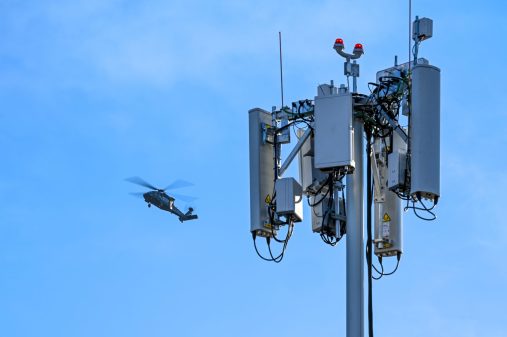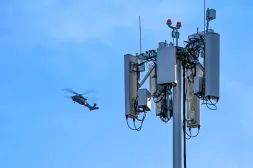FCC, NTIA move to expand spectrum access for commercial wireless in partnership with Navy

In an effort to provide greater access to 5G and high-speed internet for commercial users, the Federal Communications Commission has approved changes in spectrum management policy that would authorize wireless services for millions of residents in the United States.
The FCC announced Thursday that it had agreed to modify an existing spectrum-sharing framework used to protect the Department of Defense’s military operations conducted in the 3.5 GHz spectrum band, potentially expanding the commercial telecommunications industry’s ability to provide unencumbered internet access for millions of Americans. A proposal for the changes was submitted via a letter by the National Telecommunications and Information Administration (NTIA), which collaborated with the Department of the Navy on the request.
“The changes outlined in NTIA’s letter will expand Internet access to more people across the country,” NTIA Administrator said in a statement. “They could not have been implemented without the collaboration of the Navy and our ongoing coordination with the FCC.”
In NTIA’s letter to FCC, the organization requested to reduce the size of geographical areas where the Citizens Broadband Radio Services (CBRS) is used today and government spectrum access takes precedence over commercial — mainly along U.S. coastlines and around federal facilities.
Established by the FCC in 2015, the CBRS is a wireless communication framework that permits federal and commercial users to share the 3.5 GHz frequency band of the electromagnetic spectrum without interference. The model uses a three-tier approach to allocation, prioritizing the Defense Department’s use of the spectrum and then allowing commercial entities to access the band when the government isn’t using it.
By reducing the areas where CBRS is employed, the commercial industry could provide uninterrupted 5G services and other wireless internet to approximately 72 million people without having to navigate around the Pentagon’s schedule, according to the FCC.
Spectrum access system administrators — those responsible for managing dynamic use of the spectrum — will be required to demonstrate their ability to effectively operate under the refined model in a non-operational environment prior to full implementation, according to NTIA’s letter.
“Today, we are improving access to the 3.5 GHz band for tens of millions of Americans,” FCC Chairwoman Jessica Rosenworcel said in a statement. “The CBRS dynamic spectrum sharing framework is already fertile ground for wireless innovation, and through collaboration with Department of Defense, NTIA, and stakeholders, we are expanding opportunities for reliable spectrum access while also ensuring that federal incumbents remain protected.”
The move is the latest in a decades-long effort to improve spectrum sharing between the Defense Department and the telecommunications industry, especially as ongoing innovations in wireless technologies — from 5G broadband to autonomous capabilities — increase demand for access to the electromagnetic spectrum.
Commercial companies have found that the mid-band of the spectrum, approximately 3.1-3.5 GHz S-band, is ideal for providing high-speed wireless tech to civilian users. However, that band has been used by the DOD for decades to operate its radars, satellites, navigation systems and other equipment in military operations.
As the telecommunications industry calls on the U.S. government to reallocate part of the S-band for commercial companies to offer services and create new wireless technologies, the Pentagon asserts that doing so would require the military services to completely redesign many of their existing systems to use different frequency bands and delay other programs already under development.
Leaders at the Department of the Navy have been particularly vocal about the potential ramifications of reallocating its part of the spectrum to commercial companies, warning that the process could cost the organization billions of dollars and take decades to complete. For example, the Navy’s Aegis Combat System — equipped with multiple computers, radars and navigation systems — depends on mid-band spectrum to track incoming targets and guide weapons to destroy them.
As a result, the DON is taking a key approach to current efforts to expand spectrum-sharing possibilities in order to ensure its operations aren’t negatively impacted.
“The Department of the Navy is committed to developing a dynamic spectrum sharing capability with our industry partners to appropriately balance national economic and defense priorities,” DON Chief Information Officer Jane Overslaugh Rathbun said in a statement. “Agile spectrum access is critical to preserving the DON’s maritime warfighting competitive advantage and we are actively pursuing the development of innovative wireless solutions that will increase the quality life for Sailors and Marines.”
While the modifications to CBRS affect the 3.5 GHz range of the spectrum, the Defense Department and NTIA are working on a study to determine if any of the remaining 3.1-3.45 GHz frequencies could contribute to a future spectrum pipeline for shared use between the Pentagon and commercial industry.
The study was mandated in President Joe Biden’s National Spectrum Strategy published in November and is a follow-on effort to the Emerging Mid-Band Radar Spectrum Sharing (EMBRSS) feasibility assessment, which found that dynamic spectrum sharing with industry was feasible if “certain advanced interference mitigation features and a coordination framework” were established.
The analysis is expected to be completed by 2025, according to the White House.






